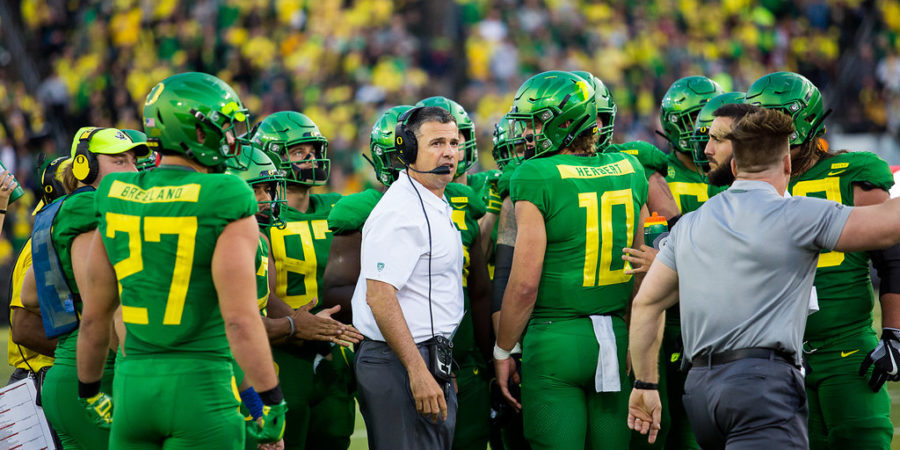With five games down and seven more to go, the 18th-ranked Oregon Ducks will get an opportunity this week to take a step back, take a deep breath, and assess the progress they’ve made through the early portion of their schedule.
Sporting an imperfect 4-1 record, optimism around the program is understandably high heading into this week’s bye. The Ducks have laid waste to three non-conference opponents in Bowling Green, Portland State, and San Jose State, and objectively looked like the better team in both their 42-24 win over then-no. 24 Cal, and their gut-wrenching 38-31 overtime loss to then-no. 7 Stanford.
With a meaty portion of the Pac-12 schedule still remaining, beginning with what is expected to be another emotionally charged atmosphere inside Autzen Stadium in two weeks when Washington comes to town, the week-to-week intensity figures to only increase as the Ducks have legitimate hopes to contend for the conference crown.
Below, WFOD takes inventory of both what we’ve liked thus far and what could stand to improve over the next several weeks.
What we’ve liked…
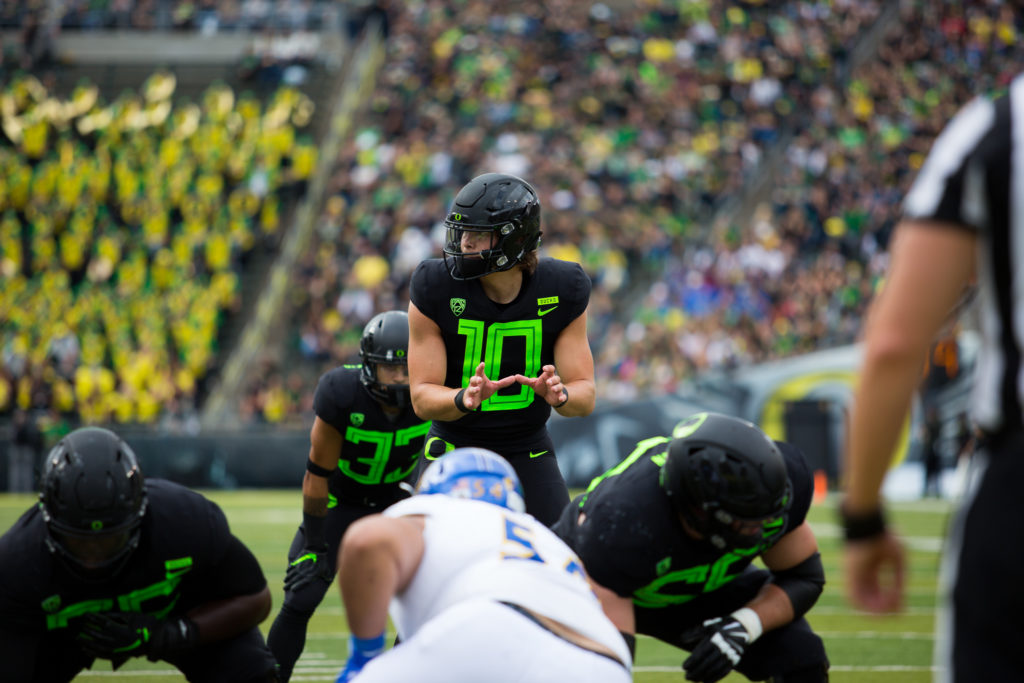
The play of Justin Herbert: The hoopla that surrounded Oregon quarterback Justin Herbert during the offseason has been justified and then some through five regular season games. Herbert’s measurables and physical tools have long had NFL scouts and execs salivating at his pro potential, but it’s his performance against ranked competition that is proving he is 100 percent deserving of all the attention he is garnering.
Against Stanford and Cal, the nation saw the best of Herbert, as the Eugene (Ore.) Sheldon High product completed 76.4 percent of his passes for 571 yards and three touchdowns (against only one interception) in those two games. For the season, Herbert is completing 63 percent of his passes for 1,438 yards, 15 touchdowns, and five interceptions, and is well on his way to earning Pac-12 Offensive Player of the Year honors provided he continues producing at his current clip. Another career-defining game lies on the horizon with no. 10 Washington headed to Eugene in a couple weeks.
The way Oregon has executed on offense: The Ducks no doubt have deficiencies – particularly at the skilled positions – that Herbert helps mask, but credit also goes to Oregon offensive coordinator Marcus Arroyo for consistently devising a game plan that has consistently put Herbert and the offense in positions to succeed. And success is something Arroyo and company have enjoyed thus far, as Oregon currently ranks no. 1 in the Pac-12 in both scoring offense (45.6 points per game) and total offense (503.6 yards per game).
Heading into the year, questions were numerous regarding Arroyo’s ability and identity as a play-caller. Through five games, it’s now safe to say that the first-year Oregon OC understands what he has in Herbert and has been effective in crafting an efficient game plan on a weekly basis. Over the next two weeks, Arroyo has perhaps his most difficult task in figuring out how to maintain success against a stingy Husky defense.
The emergence of Dillon Mitchell: We all expected Dillon Mitchell to be the leader of Oregon’s wide receiver group entering the season, but I’m not sure anyone could have predicted the kind of year he has had heading into the bye. After the first three games of the season, Mitchell was practically MIA, having tallied six catches for 98 yards and one touchdown over that span. In the last two games, however, the difference in Mitchell’s level of production has been night and day.
After posting a single game career-high in both receptions (14) and yards (239) against Stanford, Mitchell was back at it again on the road last week at Cal, hauling in seven catches for 105 yards, including a 36-yard scoring strike from Herbert. Mitchell now ranks tied for sixth in the conference in receptions (27) and is third in receiving yards (442), and has emerged as one of the most dynamic pass catchers in the Pac-12. Expect him to remain a critical component to Oregon’s success in the weeks ahead.
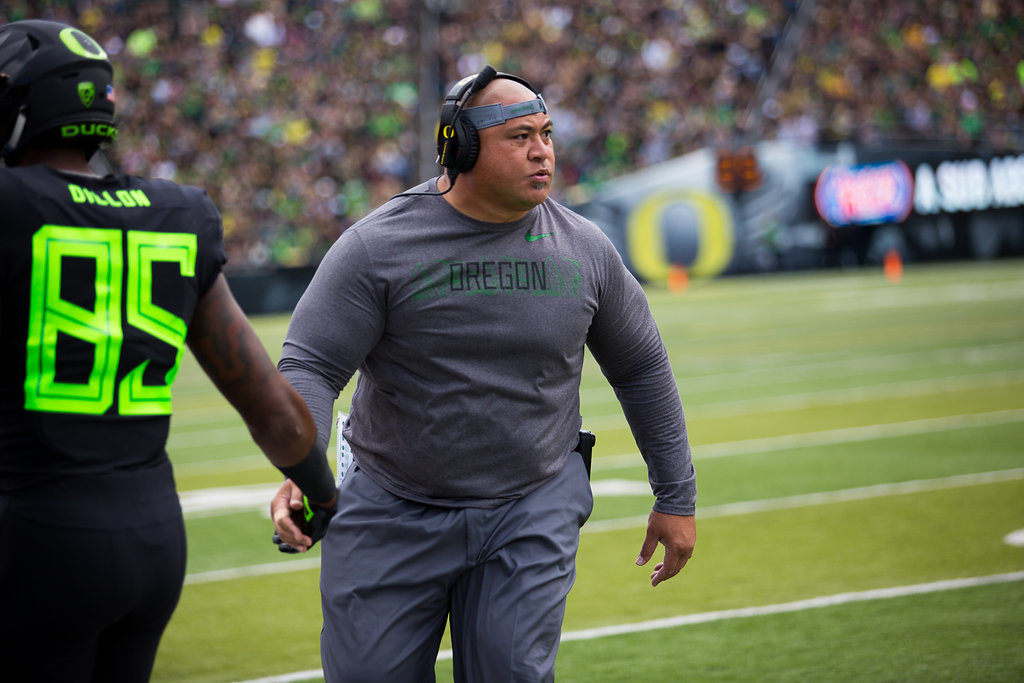
The stellar play from Oregon’s defensive front seven: Oregon’s defensive line and linebackers, which were perceived as a strength for the Ducks heading into the season, has lived up to that billing over the early portion of the schedule. In fact, one could argue that they’ve been better than advertised, particularly along the defensive line, where depth was thought to be a major area of concern before the season began. That is no longer the case, as the Ducks’ D-line core consisting of Jalen Jelks, Jordon Scott, and Austin Faoliu has been bolstered by the tremendous play of Gary Baker and Drayton Carlberg, in particular.
Oregon’s core at linebacker has also impressed. Justin Hollins is performing like the defense’s best player, while Troy Dye, La’Mar Winston, and Kaulana Apelu have been rock solid contributors as we approach the halfway point of the season. Collectively, this group has the Ducks ranking second in the conference in rushing yards allowed per game (108.6) and rushing yards per play (2.97), and is big reason for why the Duck defense is one of the best havoc-wreaking units in the entire country. Oregon currently ranks 13th nationally in overall havoc rate, which measures the percentage of plays in which a defense either recorded a tackle for loss, forced a fumble, or defensed a pass (intercepted or broken up).
The drastic reduction in penalties: After ranking as the nation’s worst team in terms of number of penalties (9.4 per game) and penalty yards (88.3 per game) incurred a season ago, the Ducks have performed a drastic about face in the span of a year. First-year head coach Mario Cristobal’s insistence on addressing the penalty issue during the offseason has taken hold during the season, as the Ducks are currently the least penalized team in the Pac-12 at just five penalties per game. That mark also ranks Oregon in the top 25 nationally.
What could stand to improve…
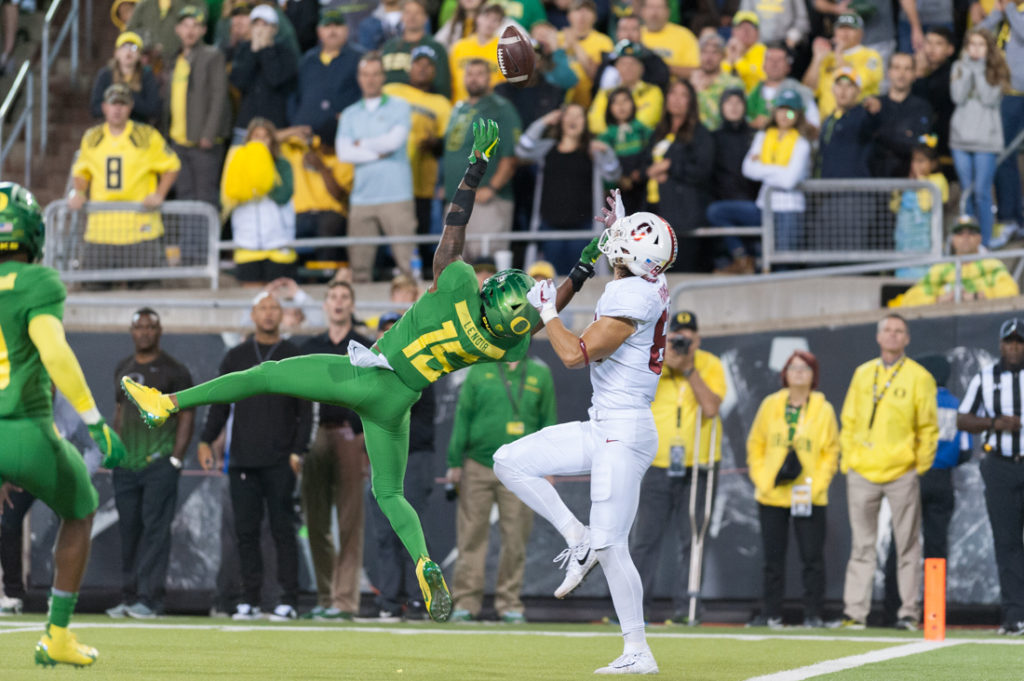
Oregon’s play in the secondary: As good as Oregon’s front seven has been, the secondary has been as spotty as any unit on the roster, particularly at corner. Despite the fact the Ducks are ranked tied for fourth nationally in interceptions (8), they’ve been Swiss cheese against the pass this season. With five games under their belt, Oregon ranks ninth in the Pac-12 in pass defense (238.2 yards per game) while also allowing the second-most touchdown passes (10) in the conference. After showing glimpses of tantalizing ability as true freshmen in 2017, Oregon corners Thomas Graham and Deommodore Lenoir have seemingly taken a step back in their play in 2018, with little depth revealing itself behind those two players.
On the bright side, play at safety has been stellar. Senior Ugo Amadi is making a strong case for All-Pac-12 first team defense honors, while true freshman Jevon Holland is playing like a potential Freshman All-American. Both players are among the nation’s leaders in interceptions with three a piece. Still, turnovers typically aren’t something you can hang your hat on. With some talented quarterbacks on the schedule in the weeks to come, the play of the secondary could be this team’s Achilles’ heel.
Oregon’s ability to close out games: While it wasn’t a notable issue in non-conference games against Bowling Green, Portland State, and San Jose State (though the game against the Spartans did reveal first signs of weakness here…), Oregon’s inability to convincingly close out games has been an area of concern through five games. No one is forgetting the second half meltdown against Stanford anytime soon (mostly due to crushing turnovers and an unfortunate – but correct – call negating a Jaylon Redd’s third quarter touchdown), but the way the Ducks struggled to emphatically finish the game against Cal served as a reminder that this team is still very much a work in progress.
Yes, Amadi’s pick six was a death knell for the Bears, as was Holland’s late interception, but if not for the timely turnovers, the win could have been dependent on an Oregon offense that wasn’t nearly as sharp as it had been in the first half. Some of that was due to a failure to execute, but some blame should be rightfully shouldered by the Oregon coaches, who went noticeably conservative down the stretch. Though the Cal game was never truly in doubt late, the ability to cleanly close out games is one area that makes you wonder whether there’s still some lingering affects from the Stanford loss.
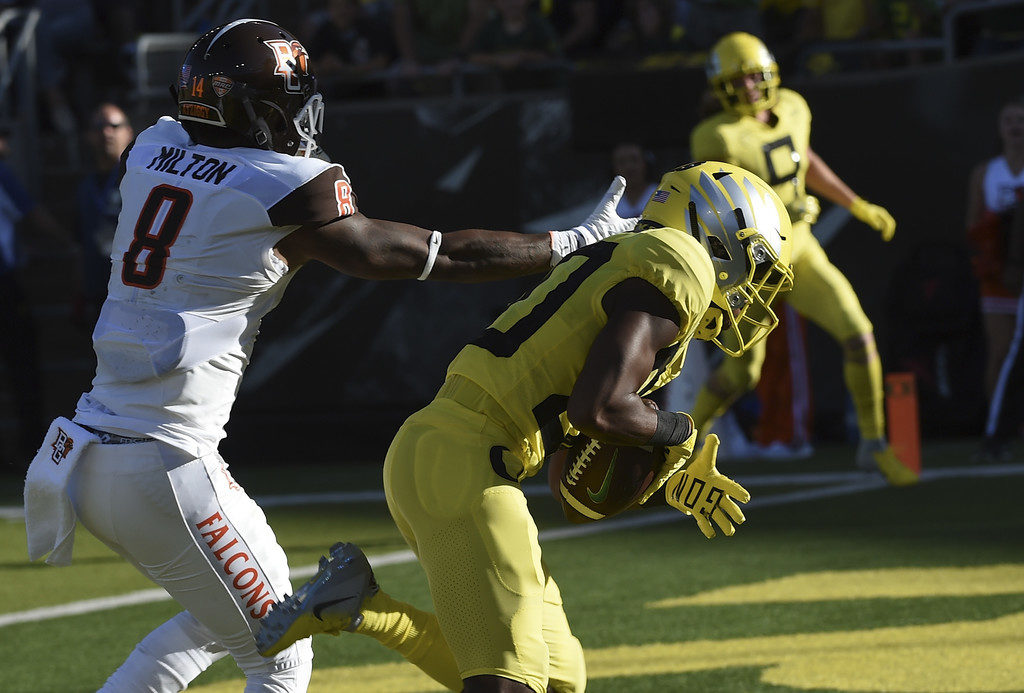
Lack of offensive playmakers outside of Dillon Mitchell: Dillon Mitchell is playing at an all-conference level right now for the Ducks, but beyond him, there’s little else in the way of skill talent on offense (excluding Herbert, of course) that is moving the needle. CJ Verdell and Travis Dye look like they are slowly but surely emerging as significant contributors in the run game, but both players are freshmen and have yet to demonstrate enough consistency (particularly in the ball security department) to feel completely confident relying upon.
The bigger question is at receiver, where aside from Mitchell, no other player has stepped up as a reliable second banana. Sophomore Johnny Johnson leads the team in touchdown receptions with four, but has been plagued by drops for most of the season. Redd is perhaps the most electric offensive player the Ducks have, but has similarly struggled with drops and has not been regularly featured within the offense. Brenden Schooler, by all accounts, had an impressive spring and fall camp but has yet to full translate that to success on the field in real-life games. Tight ends Jacob Breeland and Kano Dillon have had moments of brilliance, but similar to Redd, have not fully carved out a feature role. Against a team with a secondary talented enough to neutralize the impact of Mitchell (see, Washington), the Ducks will need one or more of their non-Mitchell players to step up and become a reliable difference maker.

